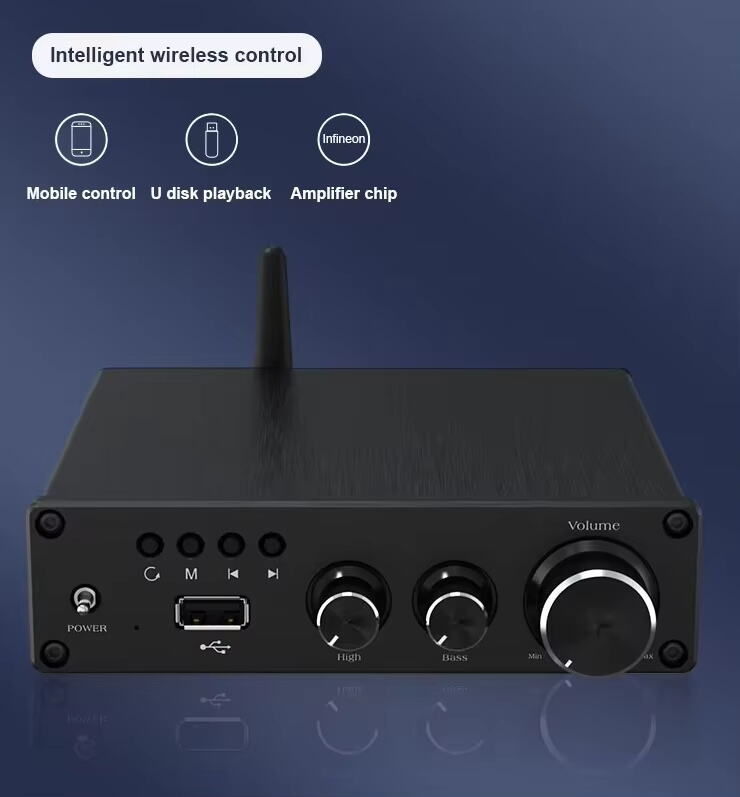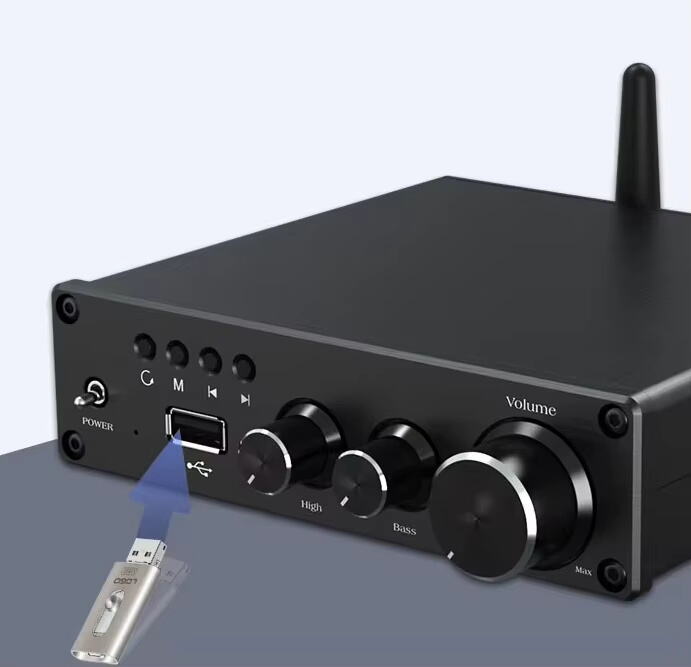Эволюция технологии усилителей
На протяжении десятилетий аудиоусилители играли центральную роль в формировании того, как мы воспринимаем звук. От радиоприемников и бытовых стереосистем до крупных концертных залов, усилители всегда были сердцем любой звуковой системы. Традиционные конструкции усилителей класса A и класса AB были прорывом в свое время, но они имели свои недостатки, такие как неэффективность, избыточное выделение тепла и громоздкость. По мере развития технологий рос спрос на более эффективные и компактные конструкции, что в конечном итоге привело к появлению Усилитель класса D .
Компания Усилитель класса D представляет собой революционный шаг вперед. В отличие от более старых моделей, потреблявших большое количество энергии и выделявших значительное количество тепла, этот усилитель достигает выдающейся эффективности благодаря инновационной технологии переключения. Он обеспечивает мощное, высококачественное звучание, сохраняя компактные размеры и легкий вес. Независимо от того, используется ли он в домашнем кинотеатре, в автомобиле или в профессиональной аудиосистеме, Усилитель класса D быстро стал предпочтительным решением для пользователей, которые ценят как производительность, так и практичность.
Что делает усилитель класса D уникальным?
Высокоэффективная технология переключения
Ключом к Успеху усилителя класса D является его уникальный дизайн. Вместо усиления аналогового сигнала в непрерывном режиме, как это делают традиционные усилители, он преобразует входной сигнал в серию высокочастотных импульсов. Эти импульсы используют широтно-импульсную модуляцию (ШИМ) для представления исходного сигнала, позволяя транзисторам усилителя работать в режиме включения/выключения.
Поскольку транзисторы находятся либо в полностью включенном, либо в полностью выключенном состоянии, потери энергии минимальны. Это приводит к высокой эффективности, которая часто превышает 90%, что является значительным улучшением по сравнению с традиционными усилителями. Более высокая эффективность означает меньшие потери энергии, более низкую температуру работы и большее количество энергии, направленной на воспроизведение звука.
Компактность без потери мощности
Еще одной отличительной чертой Усилитель класса D является компактный дизайн. Поскольку он выделяет меньше тепла, нет необходимости в тяжелых металлических радиаторах или громоздких компонентах охлаждения. Это позволяет производителям создавать более тонкое и легкое аудиооборудование без потери мощности или качества звука.
Подумайте о современных звуковых панелях, портативных Bluetooth-колонках или даже в автомобильных аудиосистемах. Все эти устройства требуют мощного усиления в ограниченном пространстве. Усилитель класса D предоставляет идеальное решение, делая качественный звук доступным без необходимости использования громоздкого оборудования.

Почему эффективность важна для вашей системы
Уменьшение потребления энергии
Одним из самых очевидных преимуществ Усилитель класса D является энергосберегающая эффективность. Зачем тратить электричество, если можно получить более высокую звуковую мощность при меньшем потреблении? Независимо от того, используете ли вы домашнюю кинотеатральную систему в течение нескольких часов подряд или питаете портативную акустику с ограниченной емкостью батареи, эффективность играет большую роль. Снижение энергопотребления не только уменьшает эксплуатационные расходы, но и продлевает срок службы батарей в портативных устройствах.
Холодная и надежная работа
Тепло является самой большой проблемой для любого усилителя, поскольку оно может сократить срок службы, вызвать нестабильность или даже повреддение компонентов. Традиционный усилитель класса А может обеспечивать отличное звучание, но часто становится слишком горячим после продолжительного использования. В отличие от этого, Усилитель класса D остается холодным даже при высоких нагрузках. Это означает более длительный срок службы оборудования, меньшую вероятность перегрева и более стабильное качество звука со временем.
Мощность усилителей класса D в реальных приложениях
Главная Системы развлечения и домашнего кинотеатра
Компания Усилитель класса D стал популярным для домашних аудиосистем. Тонкие звуковые панели, компактные книжные полки и современные ресиверы для домашнего кинотеатра используют эту технологию, чтобы обеспечить отличное качество звука без лишней занимаемой площади. Семьи наслаждаются объемным звучанием, сохраняя при этом аккуратный и минималистичный интерьер гостиной. С Усилитель класса D , вы получаете мощность большого усилителя в уменьшенном размере.
Автомобильная и портативная техника
Автомобили и портативные устройства — это среды, где эффективность и экономия пространства имеют большое значение. Автомобильная аудиосистема, оснащенная Усилитель класса D может обеспечить мощный бас и четкие высокие частоты, помещаясь в ограниченном пространстве и работая эффективно от автомобильной электросистемы. Портативные колонки также получают огромные преимущества — благодаря Усилитель класса D они могут воспроизводить звук громче и дольше, не разряжая слишком быстро аккумулятор. Это делает музыку более приятной и удобной в любом месте, куда бы вы ни пошли.
Почему стоит выбрать усилитель класса D вместо других?
Сочетание производительности и практичности
При выборе усилителя большинство пользователей задаётся вопросом: можно ли наслаждаться и высоким качеством звука, и эффективной работой? Этот Усилитель класса D усилитель идеально отвечает на него. В отличие от многих традиционных конструкций, вынуждающих выбирать между точностью воспроизведения и эффективностью, этот усилитель сочетает в себе оба качества. Обладая способностью выдавать высокую мощность, сохраняя при этом энергию, он становится выбором, который одинаково удовлетворит как профессионалов, так и обычных слушателей.
Технология, созданная для будущего
Современные технологические тенденции направлены на устойчивость, компактность и улучшенные рабочие характеристики. Этот Усилитель класса D усилитель соответствует всем этим ожиданиям. Его эффективное потребление энергии делает его экологичным, а его размеры и надёжность соответствуют растущей потребности в портативных и экономящих пространство аудиорешениях. Выбор в пользу Усилитель класса D означает инвестицию в технологию, готовую к будущему, которая и далее будет доминировать в аудиоиндустрии.
Распространенные заблуждения о усилителях класса D
Жертвуют ли они качеством звука?
Одним из самых распространённых заблуждений является то, что Усилитель класса D жертвует качеством звука в пользу эффективности. Хотя ранние конструкции могли сталкиваться с проблемами искажения, современные усилители используют передовые фильтрацию и схемотехнику для передачи кристально чистого звука. Сегодня многие профессионалы и энтузиасты сходятся во мнении, что правильно спроектированный Усилитель класса D может соответствовать или даже превосходить качество звука старых классов усилителей.
Являются ли они только для недорогих Продукты ?
Еще одним мифом является то, что Усилитель класса D встречается только в недорогих системах. Это далеко не так. Хотя они используются в бюджетных устройствах благодаря своей эффективности, многие премиальные бренды и профессиональные аудиокомпании также полагаются на Усилители класса D . Их сочетание мощности, компактности и надежности делает их универсальными для широкого спектра рынков — от недорогой бытовой электроники до премиальных аудиосистем.
Расширение сфер применения усилителей класса D
Профессиональное звукоусиление
Мир профессионального звука также получает выгоду от Усилители класса D . Концерты, мероприятия и системы для публичных выступлений требуют высокого уровня выходной мощности для обслуживания больших аудиторий. Усилитель класса D Усилитель класса D эффективно передает эту мощность, уменьшая необходимость в тяжелом охлаждающем оборудовании и снижая затраты на энергию. Это делает его предпочтительным выбором для живых выступлений, где надежность критична
Студии звукозаписи и творческие пространства
Студии и творческие помещения также требуют усилителей, обеспечивающих точность и ясность звучания. Усилитель класса D справляется с этой задачей, гарантируя точное воспроизведение каждой детали в треке. Благодаря своему охлаждению, он также избегает проблем, таких как тепловой шум, который может влиять на чувствительные среды записи.
Почему усилитель класса D — лучший выбор для вас
Если вы ищете усилитель, сочетающий мощность, эффективность, компактный дизайн и долговечность, то Усилитель класса D является очевидным выбором. Это не просто вопрос громкости звука — речь идет о поддержании стабильного качества при обеспечении долгосрочной надежности. От гостиных до студий звукозаписи, автомобилей до открытых мероприятий — Усилитель класса D безупречно адаптируется к любой ситуации.
Стоит учитывать не только то, на что усилитель способен сегодня, но и то, как он будет работать через несколько лет. Выбирая Усилитель класса D означает выбрать решение, которое останется актуальным и эффективным на долгие годы вперед.
Часто задаваемые вопросы
Что делает усилитель класса D более эффективным по сравнению с другими усилителями?
Компания Усилитель класса D использует переключающую технологию и широтно-импульсную модуляцию, что минимизирует потери энергии и преобразует мощность в звук более эффективно.
Подходит ли усилитель класса D для высококачественных аудиосистем?
Да. Современные Усилители класса D широко используются в премиальных домашних кинотеатрах, профессиональном оборудовании и системах высокой четкости благодаря улучшенному качеству звука и эффективности.
Работает ли усилитель класса D с меньшим выделением тепла по сравнению с другими типами?
Абсолютно верно. Поскольку он тратит меньше энергии на выделение тепла, Усилитель класса D остается холодным даже при высоких нагрузках, что уменьшает необходимость в крупных системах охлаждения.
Будет ли усилитель класса D служить дольше, чем традиционные конструкции?
Во многих случаях — да. Благодаря меньшему выделению тепла и стабильной производительности, Усилитель класса D продлевает срок службы оборудования, которое оно питает.
Содержание
- Эволюция технологии усилителей
- Что делает усилитель класса D уникальным?
- Почему эффективность важна для вашей системы
- Мощность усилителей класса D в реальных приложениях
- Почему стоит выбрать усилитель класса D вместо других?
- Распространенные заблуждения о усилителях класса D
- Расширение сфер применения усилителей класса D
- Почему усилитель класса D — лучший выбор для вас
- Часто задаваемые вопросы

